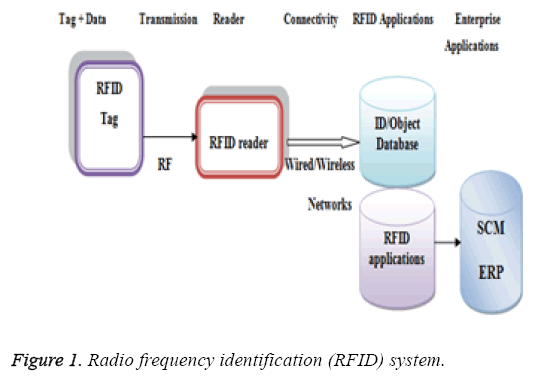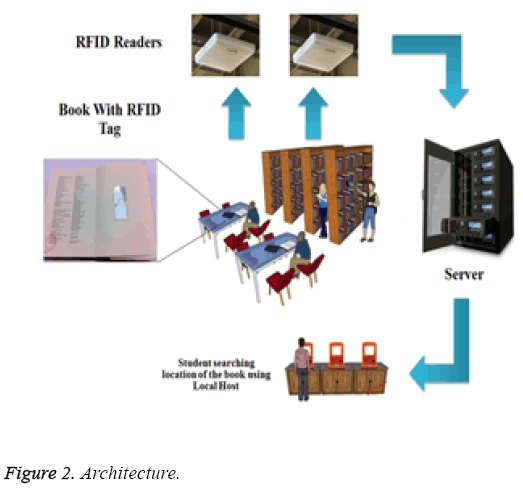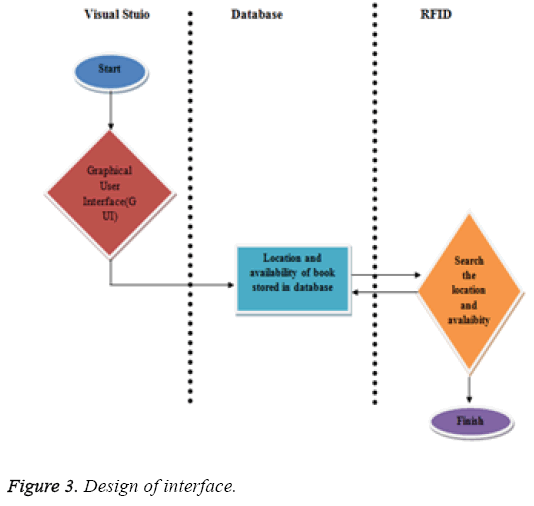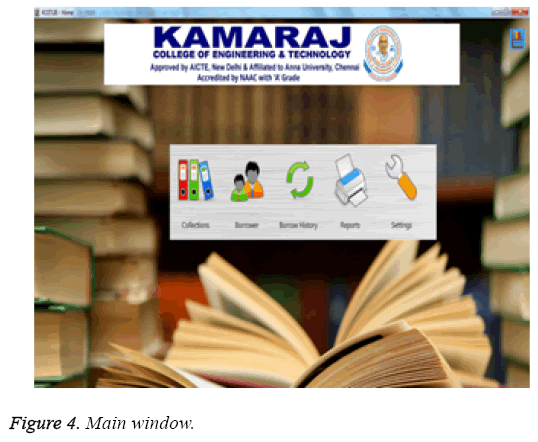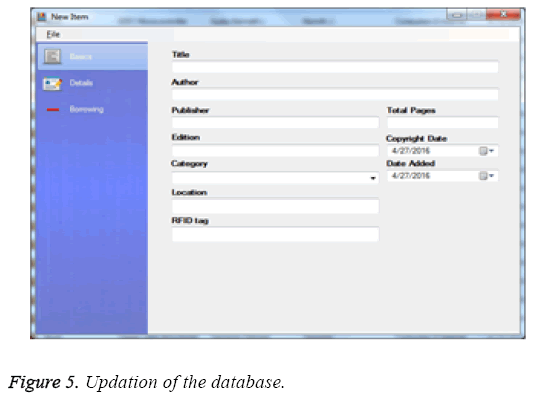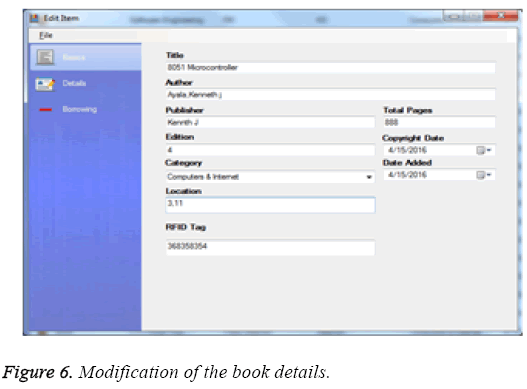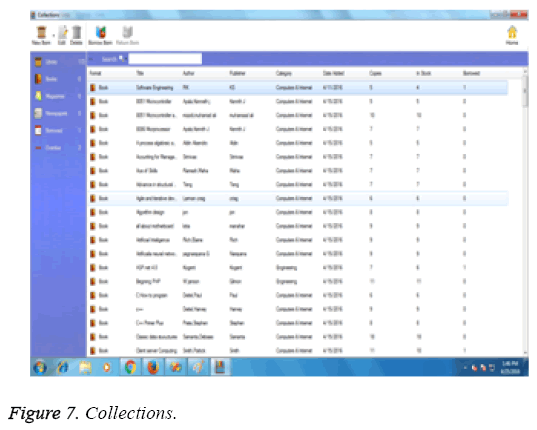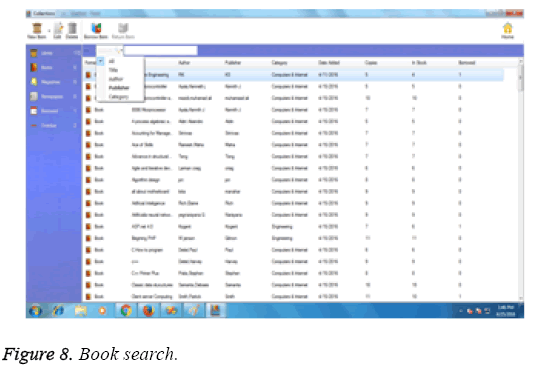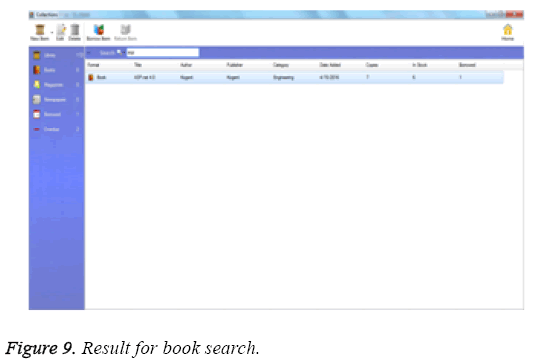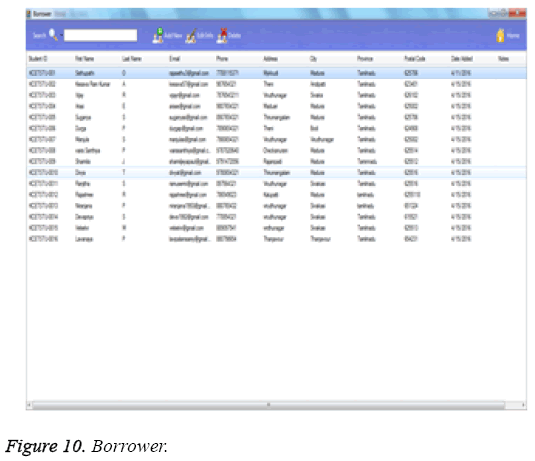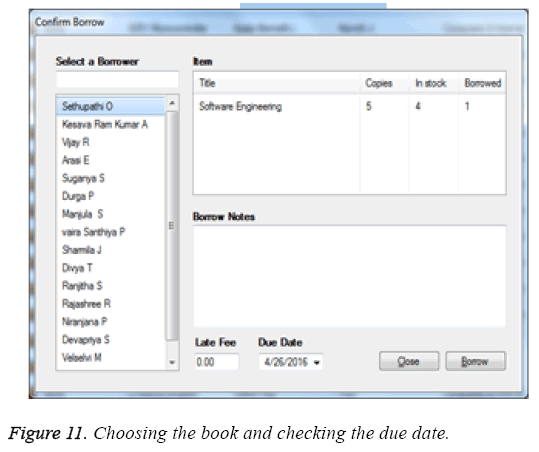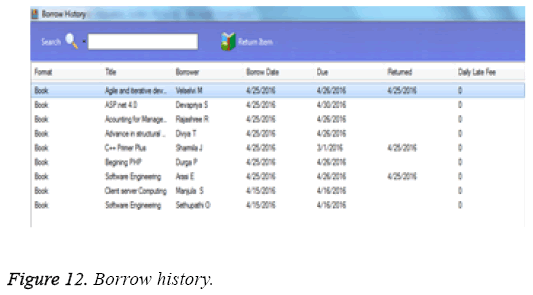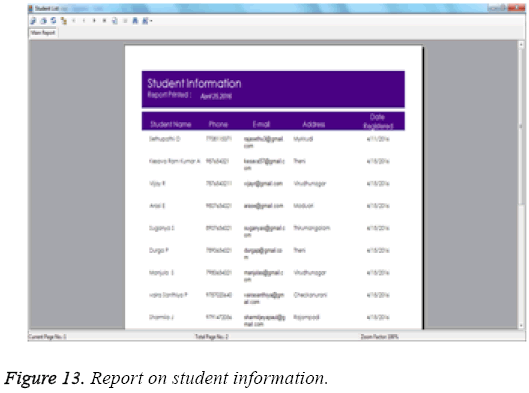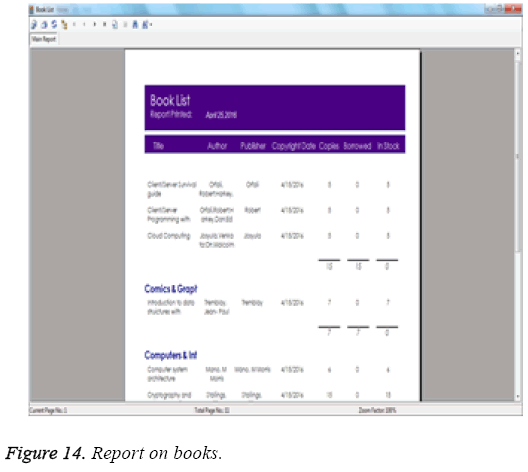ISSN: 0970-938X (Print) | 0976-1683 (Electronic)
Biomedical Research
An International Journal of Medical Sciences
Research Article - Biomedical Research (2016) Computational Life Sciences and Smarter Technological Advancement
Asset tracking and management system for library using active radio frequency identification (RFID)
Department of Computer Science and Engineering, Kamaraj College of Engineering and Technology Virudhunagar, India
- *Corresponding Author:
- Muthuselvi R
Department of Computer Science and Engineering
Kamaraj College of Engineering and Technology
India
Accepted date: August 17, 2016
In Today's world RFID (radio frequency identification) technology is one of the most popular technologies for tracking and tracing, whereby a person or an object is identified using Radio Frequency (RF) transmission using a special kind of a sensor network. Recently, radio frequency identifications (RFIDs) are used to identify the assets which are permanent objects used internally in business. Computers, tools, library books, equipment are some examples of the assets. In the proposed work, physical location of the library books can be found quickly using radio frequency identification (RFID). It reduces the searching time and hence the unnecessary wastage of time is avoided.
Keywords
Radio frequency identification (RFID), Library management, Healthcare asset tracking.
Introduction
Asset tracking refers to tracking the process of physical assets, either by scanning barcode labels attached to the assets or by using tags using Global Positioning System GPS) or radio frequency identification (RFID) which transmission their location. An asset is always tracked as a unique item. Each book or each Personal Computer (PC) is provided with unique barcode or unique RFID tag. The accurate information of the assets is required. RFID has the advantage of having the ability to recognize more than one tag simultaneously. Manual intervention is also not required to read RFID tags. Therefore, RFID technology can enable the ubiquitous use of wireless devices that have virtually unlimited lifetimes without incurring management costs [1]. In many hospitals, costlier mobile equipment is used. Tracking the equipment is very challenging and labour-intensive. It is required to track the clinical, bio-medical and the strategic assets [2]. Mobile medical equipment such as IV pumps and wheelchairs can also be tracked using RFID. Radio frequency identification (RFID) tags transmits the location of data to a computer and that can be displayed in the required places. Searching time is also very much reduced. The hospitals can improve the service quality. The comprehensive and integrated view of the assets can be maintained [2].
Radio frequency identification (RFID) technology helps the retailers to check the accuracy of the inventory. Healthcare providers and medical device manufacturers find lot of difficulties in storing, procuring and tracking the usage of Intermodulation Distortions (IMDs). Manual intervention is very much required which leads to inaccuracy in data collection and significant labour costs [3]. In this work, library books are considered as asset and library automation system using RFID is developed. RFID tags helps the librarian to track the books. It can be known that if the books are issued or they are available in the library. This project helps the librarians to locate the books quickly and avoids unnecessary delay in searching the books. The information contained on microchips in the RFID tags attached to library materials is read using radio frequency technology. While using tags, the alignment or orientation of the book is not an issue. The proposed work can be extended to healthcare asset tracking.
Literature Survey
Patrik et al. described the usage of RFID in building a smart hospital. It is suggested in this paper that business processes can be optimized and patient safety can be improved. The RFID locator, an assets tracking application is developed to improve the scalability and reliability. It is also suggested that it is important to make sure that RFID does not interfere with pacemakers and heart monitors used in the hospitals. Side effects of radio frequency on human beings have to be clarified [4]. Hoon et al. proposed a system that tracks the movement of vehicles which carry containers using RFID. It provides not only the accurate measurement of distance but also guarantees Line-Of-Sight (LOS) communication. Both practical and theoretical methods are discussed in this work [5]. Annaraman et al. proposed smart radio frequency identification (RFID) system, which identifies and tracks the books automatically. Many benefits like improved utilization of man power, infrastructures are found by using RFID system [6].
Vimalraj et al. suggested that RFID provides good solution to the libraries [7].
Srujana et al. made an attempt to implement RFID based library management system in the university. The proposed system is based on high frequency DLP radio frequency identification (RFID) 1 read/writer having the range of frequency is 13.56 MHz's and it can read up to 15 Tags simultaneously [8]. The work proposed by Lakshmi et al. is RFID based library management system. The system performs the transactions very quickly. It is very easy for the librarians to handle the issue and return of books from library [9]. Dipti et al. give brief idea about the emerging RFID technology, its importance in the library management system and its working. The various advantages and disadvantages of RFID technology in libraries are discussed. Besides, the work describes the implementation of RFID technology at central library, Indian institute of Madras (IITM). This will provide new insight for other libraries to implement RFID system [10]. Manjiri et al. proposed a library management system using RFID. The system maintains a database in which the number books to be issued and returned are stores. The student information is also stored in a database. The student is identified by the RFID card. The database is regularly updated. Using Global System for Mobile Communication (GSM) technology, due date of the book and fine amount is sent to the student [11].
Problem Description
Existing system
In the existing system, bar code technology is used. A bar code is provided for each book. Barcode reader is to be read using the reader by the librarian. Human intervention is required to issue the book, to handle the return of the book and database update. The barcodes need to be programmed at the time of manufacture and these codes can be computed only once. This process is very time consuming and lot of time is wasted.
Objective
The RFID based Library Management System simplifies the issuing, reissuing and returning of the books. The information about the book can be obtained quickly. Since automation through RFID is incorporated, human intervention is very much minimized.
Radio frequency identification (RFID) technology
Radio frequency identification (RFID) enables identification from a distance, and unlike earlier bar-code technology, it does so without requiring a line of sight. Larger set of unique IDs are supported. It is possible to corporate many data like manufacturer, product type, etc. Different tags placed in the same location can be identified by RFID system.
The technical infrastructure involves a radio transponder and receiver, more commonly known as a tag and reader. Information related to a given object is stored on a joined tag and transmitted to a reader over a Radio Frequency (RF) connection. The reader in direct connects via wired or wireless networks to servers hosting RFID applications that make use of transmitted RFID input, and, in the case of supply chain applications, middleware manages the flow of RFID data between readers and enterprise applications. Figure 1 shows technical components of an RFID system.
System Design
Proposed approach
In proposed approach introduces the asset tracking and management system for library using active RFID. Radio frequency identification (RFID) technology is one of the most popular technologies for tracking and tracing, whereby a person or an object is identified using Radio Frequency (RF) transmission using a special kind of a sensor network. Unlike a barcode system, RFID can recognize many tags simultaneously and quickly. RFID provides one of the best solutions for the identification of assets. In existing system of library management, manual process is required and students those who enter into the library search books in every rack and then get the book. This system is more inefficient and time is wasted by the students because sometimes students don't know whether books are available or not. An automated solution is proposed in this work. In the library every book is attached with RFID tag and RFID readers are connected to the host through the RS232 interface.
Architecture
Figure 2 shows overall architecture for asset tracking and management system for library using active RFID.
Interfacing design
The three important aspects need to be emphasized are Visual Basic (VB) programming language, Microsoft Access, and RFID set equipment. The whole system previously successfully implemented with the combination of these three aspects. Visual Basic (VB) was developed ease the management system to monitor the self-check in/out and book Drop. The software that has been used in this project is Visual Studio 2008; MySQL. Visual studio 2008 is used to track the book’s location and availability whereas Microsoft Access is used as storage information system. Connectivity of Visual studio and Microsoft Access are done to store the database and display the tracked location. Visual studio acts as a server of my system. Visual studio is used to track the book’s location by using passive RFID reader. The whole data is send to the Microsoft Access which is a database system as shown in Figure 3.
Results and Discussion
Experimental setup
The scope of work of the project is to develop a RFID based library management system to assist the librarians for more active management of books in the library. Graphical User Interface (GUI) for the system is developed using Visual Studio. To store the details of the book to the database, Microsoft Access is used. All the book information is loaded in the RFID tag. The student database contains the information like name of the student, email id, phone number, address, and date registered. The information has to written into the tag. The library database contains the information of the book like name, author name, publisher, number of copies in the library, available copies in the library. The database maintained with Microsoft Access using Visual Studio, which is much secured and user friendly.
When a book is issued to a student, library database the student data base is updated. The issued date and returned date of the book is updated in the student database along with student and book information. Similarly, when books are returned, library database and student database are updated. Searching of books accepting Unique Identification Number (UID) will search the information of book such as Unique Identification Number (UID), book title, book author and book publisher. The department of Computer Science and Engineering has nearly 500 books in the department library. The system is developed for the department library.
The proposed system is implemented using various modules. The modules are
• Admin
• Collections
• Borrower
• Borrow History
• Reports
Results
Figure 4 shows main window of this project. This window has four main modules.
Admin: The administrator has the authority to create the users. The library database and the student database are maintained by the administrator. These are shown in Figures 5 and 6.
Collections: This module lists all the information about the library. This module have search box. In this search box, Searching for books using Unique Identification Number (UID) will search the information of book Unique Identification Number (UID), book title, book author and book publisher. Search/Issue book's screen accessed from actions screen, in this screen search and issue is done. First user enters the criteria for book searching and a book is successfully finding than the user can select the book he wishes to get issued in grid and get it issued as shown in Figure 7.
Figures 8 and 9 show how the book can be searched and the result of the search respectively.
Borrower: This module lists all the information of the student those who have registered in the application. It displays the automatically generated identification, first name, middle name, last name, address, gender, age, year, department, mobile. It gives an edit link, from which administrator can edit the submitted information as shown in the Figure 10. Each student can choose the book from the drop down list. The due date for the book is also displayed. The screen shot is shown in Figure 11.
Borrow history: This module lists all the information of the borrowed books. This module displays the borrower details, issue date, return date and fine details. Then borrower can return the book using this module as shown in Figure 12.
Reports: The module contains various facilities like student report, book report, and transaction report. It allows you to export the information from the reports to spread sheets or text files to use them in other applications. It generates all reports automatically and very easily as shown in Figures 13 and 14.
Conclusion
Radio frequency identification (RFID) implementation in libraries has been discussed. The whole system was designed to overcome the disadvantages of barcode systems and thus demonstrated. The entire project was planned to reduce the need of skilled librarians. Though the system is more expensive than the barcode systems, security is ensured and is more efficient. RFID in library speeds up all the techniques like issuing, reissuing returning books, books searching processes. Performance of a system depends upon the data on the tag, effectiveness of RFID reader position, tag position and they all depend upon the cost. Developments in RFID technology continue to earn larger memory capacities, wider reading ranges, and faster processing. Renewing of manual book keeping, books are now more comfortably traceable, improved utilization of resources like manpower, framework, etc. Less time consumed as no line of sight is mandatory, minimized manual intervention, minimized manual errors, and fast access to books are the main advantages after implementation of RFID based Library Management System (LMS). An automated RFID based Library Management System (LMS) will increase the speed of action as issuing and returning back is now automated.
Future Work
In future the tag system can be implemented in any type of asset tracking, especially in multi-national offices to keep track in their office files, often DVDs. It can also be used in hospitals for healthcare asset management to track and maintain equipment.
References
- Sekyoung Y, Yongwoong J. Radio frequency identification (RFID)-based automatic scoring system for physical fitness testing. IEEE Sys J 2015; 9.
- Radio frequency identification (RFID) and Real-time locating system in healthcare. Oat sys 2013.
- New cognitive approaches to long-standing challenges. IBM Smarter Cities 2016.
- Hoon C, Yunju B. Design and implementation of practical asset tracking system in container terminals.Int J PrecisEng Manufactur 2012; 13: 1955-1964.
- Srinivasa Ravi K, Varun GH,Vamsi T,Pratyusha P. Radio frequency identification (RFID)based security system. Int J InnovTechnolExplorEng2013; 2: 132-134.
- Annaraman PT. Smart library management system using Radio frequency identification (RFID). Int JAdv Res Electric ElectrInstrEng2015; 4: 1916-1925.
- Vimalraj S, Sameera S. Radio frequency identification (RFID)based library management system. International J Innov Res AdvEng2015; 2: 326-329.
- Srujana C, Rama Murthy B. Development of Radio frequency identification (RFID) based library management system using MATLAB. Int J EngAdv 2013; 2: 480-482.
- SreeLakshmi A, SreeGowri A. Library management system using Radio frequency identification Technology (RFID). Int J Comp Sci Info Technol 2014; 5: 6932-6935.
- Dipti RS, Dhara S. Radio frequency identification Technology (RFID) at central library, IIT Madras. Int JSciEngApplSci 2015; 1: 156-172.
- Manjiri A, Vinaya C. FPGA based library management system.Int J AdvRes CompSci Soft Eng 2015; 5: 294-298.
